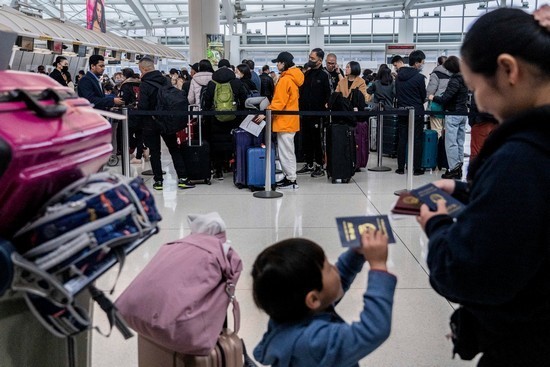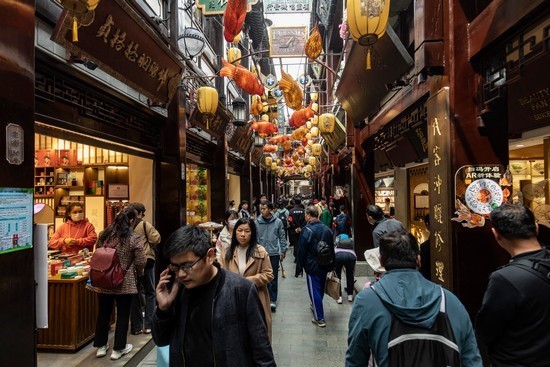When the Chinese government
announced last month that it would fully reopen its borders to foreign
travelers, the news came as a jolt of relief to the millions of Chinese
immigrants overseas who have been separated from their relatives since 2020.
اضافة اعلان
But a flood of visitors has yet to arrive.
Many people are struggling to even book a plane ticket, stymied by high prices and
a lack of direct flights.
Liu Wei, 62, who lives in San Diego,
recently spent hours at a local travel agency filling out a pile of paperwork
to obtain a long-term visa to China. After searching for weeks for a flight,
she bought a ticket for later this month to reunite with her sisters in the
northeastern port city of Dalian. Round-trip business-class tickets from San
Diego to Dalian cost between $6,000 and $10,000, she said, double what she
typically paid before the pandemic.
“I miss the choice and the freedom to go
back and forth,” said Liu, who used to visit China every summer. “It’s been
such a tragedy for us to not be able to go back to our own country.”
‘Zero COVID’ ripple effectFor nearly three years, China maintained
some of the harshest travel restrictions in the world, largely sealing off its
borders to business travelers, tourists, and relatives of Chinese nationals.
The ruling Communist Party enforced a “zero COVID” policy, attempting to
eradicate the coronavirus with prolonged lockdowns and mass testing.
Overseas visitors who did manage to enter
China were sometimes forced to quarantine for up to two months at their own
expense. Some travelers even had to undergo anal swab COVID testing, triggering
protests from governments outside China.
“I miss the choice and the freedom to go back and forth,” said Liu, who used to visit China every summer. “It’s been such a tragedy for us to not be able to go back to our own country.”
China’s isolation had broad ripple effects.
Universities shut down academic exchanges with the mainland, and multinational
companies shifted their supply chains to other countries. The millions of
Chinese immigrants overseas — in countries such as the US, Britain, Canada, and
Malaysia — suffered the heaviest emotional cost, unable to return home to care
for sick parents or bury relatives who died during the pandemic.
In December, China abruptly ended its “zero
COVID” policy and soon began to ease border restrictions, removing quarantine
requirements for international arrivals. The following month, business
travelers were allowed to return on special visas.
A flight supply problemThe biggest barrier came down last month
when the Chinese government resumed issuing tourist visas. China has also said
it would reinstate the 10-year visas that had been suspended during the
pandemic, facilitating the travel of many overseas visitors.
In a sign of pent-up demand, right after
the Chinese government announced the loosened restrictions, searches on
Expedia.com for travel from the US to mainland China jumped around 40 percent
from a month earlier, according to data provided by the online travel company.
 A check-in line for a China Eastern Airlines flight to
Shanghai at Kennedy International Airport in New York on April 5, 2023.
A check-in line for a China Eastern Airlines flight to
Shanghai at Kennedy International Airport in New York on April 5, 2023.
Prices have stayed high partly because
airlines have been slow to ramp up their flights to China. Globally, the number
of flights into China in March were only about one-quarter of what they were in
the same month in 2019, according to Cirium, an aviation data provider.
Routes between the US and China, the
world’s two largest economies, have been capped because of geopolitical
tensions. During the pandemic, the two rivals suspended each other’s flights in
a political tit-for-tat, and airlines need the approval of both countries’
aviation authorities to increase routes.
Since invading Ukraine more than a year ago, Russia has banned the US and European carriers from flying through its airspace, meaning flights to China now require longer routes with more fuel and flight crew.
US and European carriers are not as eager
to resume all of their pre-pandemic flights to China, aviation analysts say.
Since invading Ukraine more than a year ago, Russia has banned the US and
European carriers from flying through its airspace, meaning flights to China
now require longer routes with more fuel and flight crew.
US carriers have been lobbying Washington
to force Chinese airlines, which are still flying over Russia, to use the same
routes as their American competitors, arguing that they have an unfair cost
advantage.
 Tourists in the city temple bazaar
surrounding the Yuyuan Gardens in Shanghai.
Tourists in the city temple bazaar
surrounding the Yuyuan Gardens in Shanghai.
A spokesperson for the US Department of
Transportation did not provide comment on when routes to China might increase.
Business classDirect flights between the US and mainland
China are hard to get. Last month, Delta Air Lines and American Airlines both
resumed direct flights to Shanghai from hubs in Detroit, Seattle, and Dallas,
but only a handful of times per week. United Airlines operates a direct flight
from San Francisco to Shanghai four times a week. None of the airlines has any
direct flights between the US and Beijing.
For now, the visitors who can most afford
to fly to China are business travelers, who have been filling up premium cabins
into the mainland.
China has rolled out the red carpet for
foreign business officials, part of an effort to revive its economy after years
of COVID lockdowns. Dozens of chief executives, including Tim Cook of Apple,
flew to Beijing to attend last month’s China Development Forum, where China’s
newly elected premier, Li Qiang, pledged that “the door to China’s opening will
grow wider”.
For now, the visitors who can most afford to fly to China are business travelers, who have been filling up premium cabins into the mainland.
Many executives are eager to visit with
employees and suppliers for the first time since 2020.
A February survey of 43 American companies
showed that 50 percent of chief executives planned to visit China in the first
half of this year, according to the US-China Business Council, a trade group in
China.
“The Chinese government has sent some
signals for support about private companies, but at the same time, it’s a tense
geopolitical environment,” said Jack Kamensky, a senior director at the
business council.
Read more Travel
Jordan News







